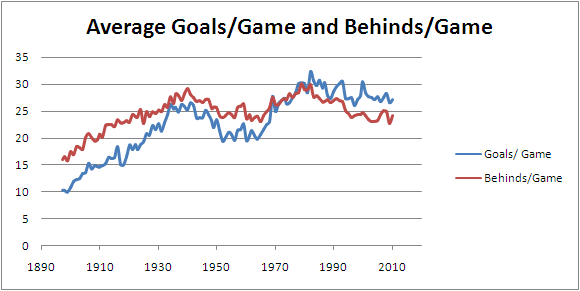Goalkicking Accuracy Across The Seasons
/Last weekend's goal-kicking was strikingly poor, as I commented in the previous blog, and this led me to wonder about the trends in kicking accuracy across football history.
Just about every sport I can think of has seen significant improvements in the techniques of those playing and this has generally led to improved performance. If that applies to football then we could reasonably expect to see higher levels of accuracy across time.
That has certainly been the case in football if we use as our measure of accuracy what I'll call 'percentage' and define as goals divided by goals plus behinds, as you can see in the following chart:
For the first 70 years of the competition, spectators would turn up to games expecting to see fewer goals kicked than behinds. In fact, it wasn't until 1969 that a whole season produced more goals than it did behinds, and it wasn't until 1976 that this became a regular occurrence (with one hiccup, in 1981).
The best season of all in terms of percentage was 2000 when the competition's 16 teams combined to produce a season-long percentage of 55.2%. Since then the general trend has been downward though the last two full seasons have bucked this trend and delivered percentages of around 53% and 54%.
The general improvement in percentages commencing about 1980 has come as a result of the more rapid decline in the number of behinds per game than in the number of goals per game. Goals per game peaked in 1982 at 32.4 and behinds per game peaked a few seasons earlier in 1979 at 30.1. Since then, looking at the average for the last 5 completed seasons, goals per game are down by about 5 and behinds per game are down by about 6.
It's interesting to note that we are now experiencing about the same number of behinds per game as spectators did in the late 1960s, but we're seeing about 5 or 6 more goals per game than they did. As we start to accumulate a history of seasons with the new rushing laws we might even return to the levels of behinds per game witnessed just after the turn of the century, when teams recorded only about 20 behinds a game between them, about 4 fewer than now.
We've looked at aggregate scoring across entire games, but what about scoring within different quarters.
Analysis shows that, across every football era the tendency has been for more goals to be kicked in each successive term while the number of behinds has tended to remain fairly constant across the quarters. Consequently, within each era kicking percentages have tended to increase from quarter to quarter.
Focussing our attention on the last 60 or so years of the competition, we find that each decade, commencing with 1950-59, has seen about 5 to 10% more goals kicked in the final term of games compared with the goals kicked in the first term. At least that was true until the 2000-2009 period, during which the difference was only 3.5%, perhaps reflecting the better match conditioning of today's players, which allows them to produce more consistent defensive performances across entire games.
One particular comparison is instructive. In 2000-2009 teams kicked just 0.25 fewer goals per game in first quarters than they did in 1980-1989, but they kicked about 0.75 fewer goals per game in final terms. That final term difference alone accounts for almost 40% of the decline in average point-scoring between the two decades.
So we now know that teams tend to kick more accurately in the later parts of games. That led me to wonder one last time and ask might they also kick more accurately as the season progresses.
The answer - looking at the home-and-away games in seasons 1995 to 2009, since these seasons are all recent and of equal length (22 rounds) - is a resounding no.
I'll leave you with just one piece of trivia. In the history of the game 327,882 goals and 339,970 behinds have been registered. Currently, about 4 more goals are scored per game than behinds. At that rate it'll take over 3,000 games or at least 17 years because there'll have been more goals kicked than behinds. May we all be there to see that happen.





